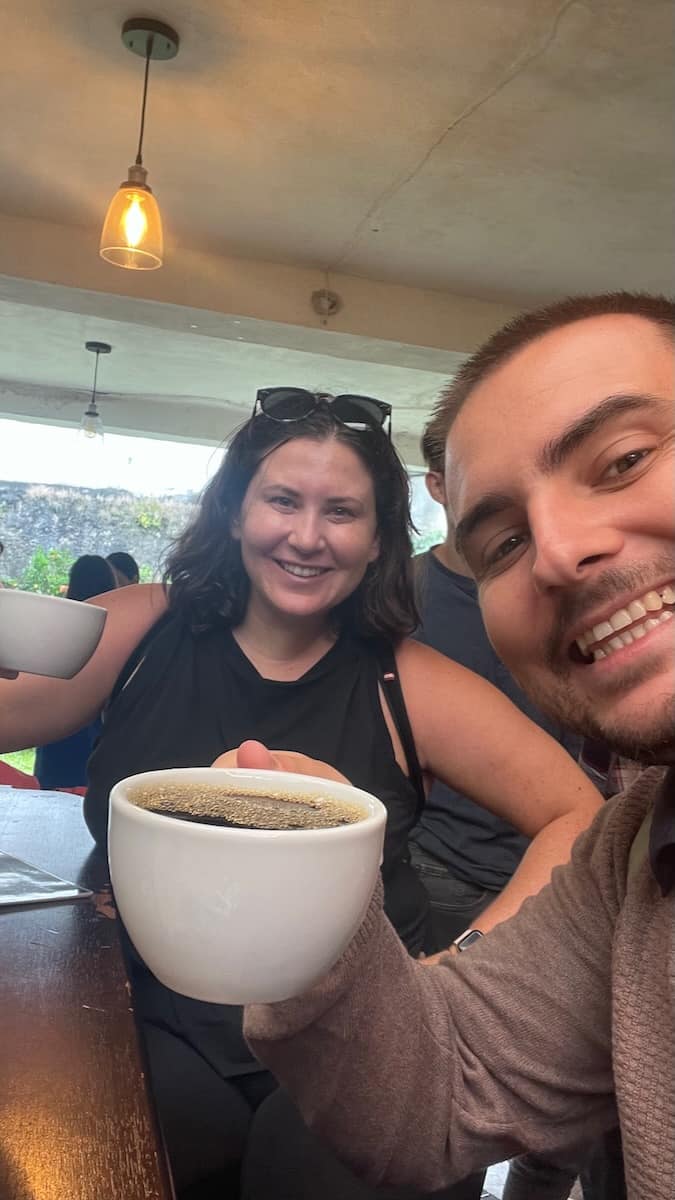12 Epic Things to Do in Juayua: El Salvador Hidden Gem
Cat is Out of the Office contains affiliate links and is a member of the Amazon Services LLC Associates Program. If you make a purchase using one of these Amazon links, I may receive compensation at no extra cost to you. See my Disclosure Policy for more information.
Juayua (pronounced why-YOO-wuh) is a must-visit on El Salvador’s Ruta de las Flores.
As a seasoned solo traveler, Juayua’s blend of adventure and culture hooked me.
Its central location makes it an excellent base for exploring the region, offering walkable streets and a lively atmosphere.
The Seven Waterfalls Hike and the weekend Food Festival (Feria Gastronomica) were personal highlights – although I don’t recommend hiking the day after a hurricane (oops).
Despite its reputation, El Salvador, particularly Juayua, was a highlight of my seven months in Latin America. This small pre-Columbian Náhuat town offers a unique experience of authentic Salvadoran life, with cooler temperatures and a variety of things to do.
Whether you’re arriving via a crazy chicken bus ride, renting a car, or hiring a driver, Juayua is accessible and worth every effort to visit.
👉 I highly recommend this tour for exploring the Ruta de las Flores.
This small group tour boasts a near-perfect 5-star rating and is a fantastic way to meet other adventurers.
You’ll experience the Salto de Malacatiupan waterfalls and Santa Teresa Hot Springs, enjoy a thrilling bike zipline, and more, all with the peace of mind of knowing you’re in great hands.

1. Seven Waterfalls Hike
Hiking Seven Waterfalls in Juayua turned out to be one wild adventure, way more intense than I expected.
Honestly, I’m not much of a hiker and didn’t know what I was getting into, especially since we went right after a hurricane.
Picture this: slipping and sliding through mud, climbing up the Juayua waterfalls without any ropes, and trying not to look down as we semi-rappelled down a (small) cliff. It was nuts but in the best way possible.
Getting a local guide is necessary. They knew the trails like the back of their hand, helping us across rivers and through coffee farms, making sure we didn’t miss out on any of the cool spots to take a dip.
The hike wrapped up at Los Chorros de la Calera, where we chilled in these awesome man-made pools at the waterfall’s base.
My amazing guide was Elizabeth Hernández. She made the whole thing feel like an adventure with friends rather than a guided tour. You can message her on Whatsapp (+503 6113 7277) or check her socials (Facebook and Instagram).
Trust me, doing this hike without a guide would be pretty intense and not in a good way. Plus, it’s a solid way to support the locals.

2. Los Chorros de la Calera
If the Seven Waterfalls hike sounds like a bit much (and let’s be real, it’s intense), but you’re still itching to check out an epic waterfall, Los Chorros de la Calera is your spot.
It’s only $2.50 USD to get in. It’s man-made and helps supply water to the towns around it.
You can grab a tuk-tuk or just hoof it from the main square, which takes about 20 minutes.
A local guide can take you through coffee plantations on the way there, which is pretty cool.
Once you’re there, you can swim in these amazing pools. The guides even show you how to swim through the tunnels. The water’s super clear and fresh – perfect for cooling off.
And if you’re worried about safety, there’s often a police officer hanging around on weekends to keep an eye on things. If you’re going during a quieter time like a weekday, you can actually ask the police in town to walk you over there for free, which is pretty handy.

3. Juayua Food Festival
If you’re anything like me and think that the best part of traveling is all about the food, then you’ve got to make a beeline for the Juayua Food Festival or Feria Gastronomica de Juayua when you’re in El Salvador.
Every Saturday and Sunday, around 11am-5pm, the area around Juayua’s Central Park transforms into a foodie’s paradise. Imagine the smell of grilled meats wafting through the air, music everywhere, and a mix of locals and travelers all there to dig into some seriously tasty eats.
And the best part? Dishes usually cost between $1-5 USD, so you can go all out without breaking the bank.
I dragged a friend from my hostel in Santa Ana with me so we could share plates, and I could stuff my face with twice as many dishes, everything from succulent grilled meats to fresh seafood.
For anyone planning a trip to Juayua, the Food Festival is the perfect way to wrap up a morning hike or to spend your whole afternoon if you’re all about that eating life. Just remember to bring cash and maybe a buddy to share with – it’s the ultimate foodie strategy.
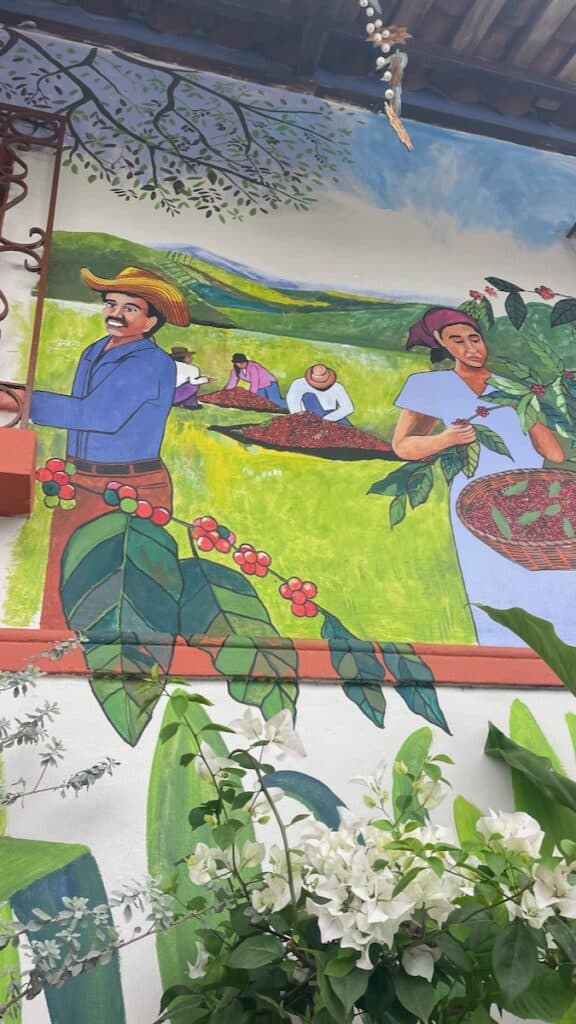
4. Juayua’s Street Art
Juayua isn’t just about natural beauty and culinary delights – it’s also a canvas for incredible street art that adds a vibrant layer to this already colorful town.
As you stroll through the streets, you’ll notice that the walls of cafes, restaurants, and shops become the backdrop for a dynamic art gallery. Local artists have turned these spaces into a showcase of creativity, ranging from whimsical surrealist pieces to lifelike portraits.
Each mural tells a story, reflecting the culture, dreams, and everyday life of Juayua’s people. It’s like walking through an open-air museum, where each turn offers a new visual feast.
I found myself constantly stopping to admire these artworks that so vividly capture the spirit of the place.
This blend of art in everyday spaces makes Juayua’s street scene unique. It’s a reminder of how art can transform the ordinary into something extraordinary, inviting visitors to see the world through the eyes of its local creatives.
This artistic flair isn’t confined to Juayua alone – the neighboring towns (especially Ataco) along the Ruta de las Flores also boast impressive art scenes.
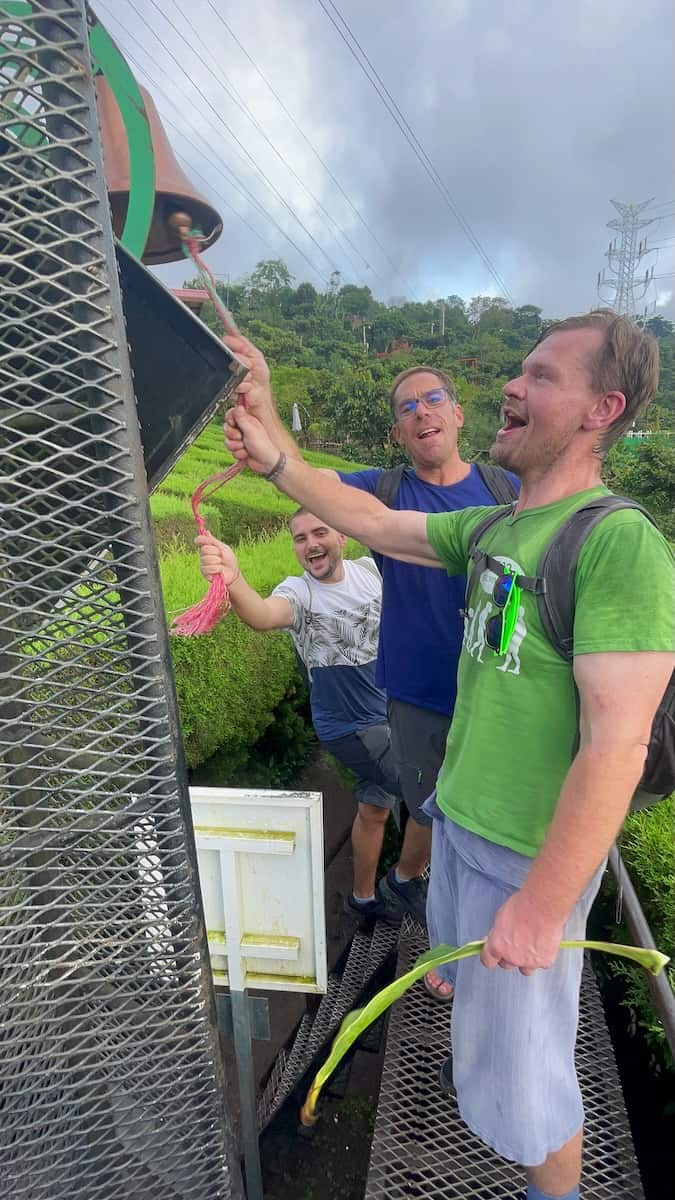
My top pick is this Thermal Tour: Café Albania + Hot Springs + Ataco + Lunch, with a near-perfect 5-star rating.

5. Explore Juayua Town in the Old-Fashioned Way
Exploring Juayua doesn’t have to be on foot alone – the town offers more charming ways to see its sights.
You can step back in time with a carriage ride, feel the adventure on horseback, or even catch a little train ride around the town.
These unique modes of transport provide a leisurely pace to take in the town’s beauty, perfect for those looking to soak up the ambiance without the rush.
The town center of Juayua is a hub of activity and culture. Wandering through, you’ll find craft shops brimming with local artisans’ work, cozy cafes where you can sip on Salvadoran coffee, nurseries with local plants, inviting restaurants, and art galleries showcasing local talent.
Of course, walking remains a fantastic way to explore Juayua at your own pace, allowing for spontaneous detours and intimate encounters with the town’s vibrant life. Personally, I like to walk, but you do you!
🌸 The highest-rated and best Ruta de las Flores tour is Thermal Tour: Café Albania + Hot Springs + Ataco + Lunch (Rated 5 out of 5 Stars)

6. Santa Lucia Church (Cristo Negro Church)
Santa Lucia Church, or Cristo Negro Church as it’s known locally, is one of those places in Juayua that you just feel drawn to visit.
It’s got this old colonial vibe that tells you stories before you even step inside.
The church has been through a lot – first built from adobe, it got knocked down by an earthquake in the 18th century. Then, they tried wood, but it got taken out by a fire. They didn’t give up, though; they rebuilt it in 1957, dedicating it to Cristo Negro this time.
Inside, there’s this incredible Black Christ statue, carved way back in the late 16th century by Quirio Cantano. It’s got a twin over in Guatemala, in the Basilica of Esquipulas, but this one feels like it belongs right here in Juayua.
If you’re in Juayua in January, from the 8th to the 15th, the place comes alive with celebrations for the patron saint. It’s something else, seeing how much this statue and church mean to everyone here.

7. Juayua’s Festival del Cristo Negro (January 8-15)
If you’re in Juayua during January, you’re in for a spectacular treat. The town’s annual Festival del Cristo Negro, peaking on the 15th, transforms Juayua into a hive of celebration that takes the vibe to another level.
It’s not just about the church – it’s about the whole town coming alive.
The festivities kick off days in advance, with the weekly food festival expanding into a full-blown feast that fills the streets around the main square with music, lights, and an air of jubilation.
During the festival, day drinking becomes a local sport, accompanied by an abundance of Salvadoran cuisine designed to keep you fueled and ready for what’s to come.
The streets don’t quiet down when the sun sets – instead, they become the stage for a grand parade featuring ornate floats and beauty pageant contestants, a tradition that might seem odd but is wholly Salvadoran.
But the real adrenaline rush comes with the Running of the Flaming Bulls. Imagine men charging through the streets with wooden and paper bulls on their heads, fireworks shooting off in all directions, creating a spectacle of light, sound, and sheer excitement.
It’s chaotic, it’s wild, and it’s utterly unforgettable.
The night caps off with a grand fireworks display near a statue of Cristo Negro, right in the heart of Juayua, wrapping up the festivities with a sky full of color.
I hope you brought your earplugs – it wouldn’t be Central America without fireworks going off all night!

8. Eat Pupusas
No trip to Juayua, or anywhere in El Salvador for that matter, is complete without diving into the world of pupusas, and I’ve got to admit, I’m totally obsessed.
There’s this spot, Pupusería Esmeralda, where they dish out these heavenly stuffed tortillas that are basically a hug in food form. Whether you go for the classic chicharron (pork) or frijol (bean), you can’t go wrong.
My go-to is the loroco with cheese – loroco being these small green flower buds that pack a punch of flavor. It’s like nothing else.
Pupusas have stolen my heart as the ultimate street food across Latin America, so you bet they’re a top highlight for anyone hitting up the Ruta de las Flores.
The pupusas at Pupusería Y Taquería Doña Cony are also out of this world.
Seriously, if you’re in Juayua, do yourself a favor and make eating pupusas a top priority. They are super cheap, usually less than $1 USD, so eat as many as you want!

9. See Flowers in El Salvador
Have you ever wondered where Ruta de las Flores got its name? You’ve got to check out the Ruta de las Flores right after the rainy season wraps up.
For a few magical weeks between February to April, Mother Nature goes all out, and the whole countryside turns into a carpet of colors.
But here’s the thing – pinning down the exact time these blooms decide to throw their party is a bit of a guessing game since it changes every year.
So, if you’re planning to catch this floral spectacle, keep your plans flexible.
When you do hit it right, though, it’s breathtaking.
And all those white flowers that you see? Likely from the coffee plants found all over the region!
👉 My top pick for the best Ruta de las Flores small group tour is the Thermal Tour: Café Albania + Hot Springs + Ataco + Lunch, with a near-perfect 5-star rating. You’ll visit Salto de Malacatiupan waterfalls, Santa Teresa Hot Springs, hop a bike zipline, and more!

10. Tour a Coffee Farm
Let me spill the beans on another must-do activity in Juayua – diving into the world of coffee. El Salvador grows some of the best coffee in the world!
Coffee farms in Ruta de las Flores open their doors for some of the most aromatic and enlightening tours you can imagine. Hotel Anahuac offers one popular coffee tour.
Think picking red coffee berries, following their journey to becoming those golden-brown beans we obsess over, and then wrapping it all up with a tasting that’ll have your taste buds singing.
And it doesn’t stop at coffee farm tours. Places like Hotel and Restaurant Santa Leticia (in Apaneca town) turn coffee love into an experience, offering lodge accommodations on the farm. Imagine waking up to the scent of coffee in the air – that’s the dream, right?
Then there’s El Carmen Estate, where you can tour (for just $6 USD) and stay in a gorgeous country villa.
If you don’t have time for a full coffee plantation tour, get your caffeine fix at Finca Rancho Monte Hebron, a cafe with a peaceful atmosphere and amazing coffee. There’s also the beautiful Cafe Pacamara.

11. Laguna de las Ranas (Frog’s Pond) & Los Naranjos Hike
Laguna de las Ranas (Frog’s Pond), located between Ahuachapan and Sonsonate towns, earns its name from the numerous frogs in the area.
This spot remains relatively undiscovered, with limited online information, highlighting its appeal as a pristine off-the-beaten-path destination.
Visitors interested in exploring this hidden gem should seek guidance from locals and consider hiring a guide who knows the area.
The journey to Laguna de las Ranas and a hike through the aromatic orange groves of Los Naranjos offers a refreshing outdoor adventure.
The hiking route to Los Naranjos, which connects Santa Ana and Sonsonate and passes through the picturesque town of Ataco, provides a wonderful opportunity to experience the area’s natural beauty and local charm.
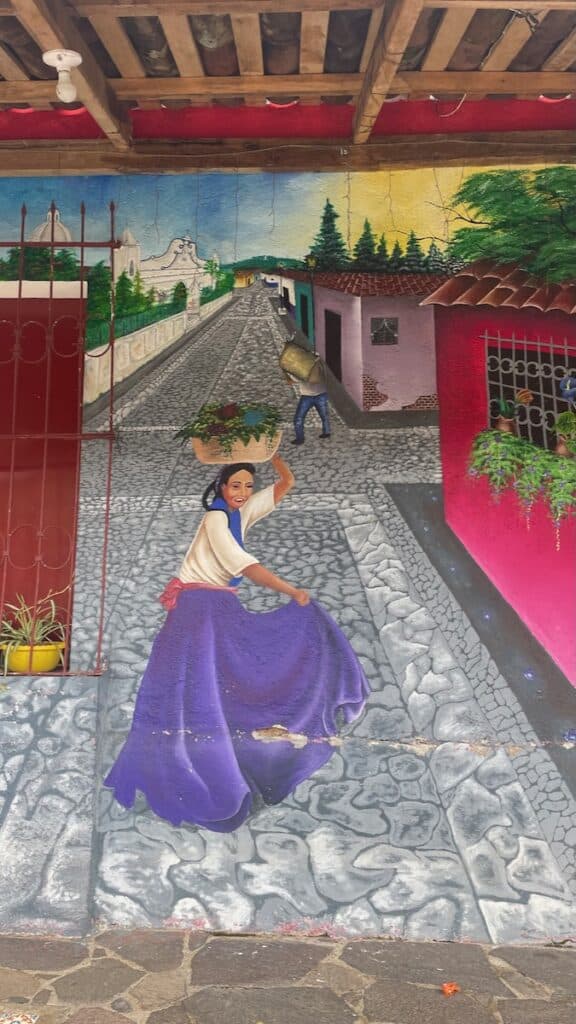
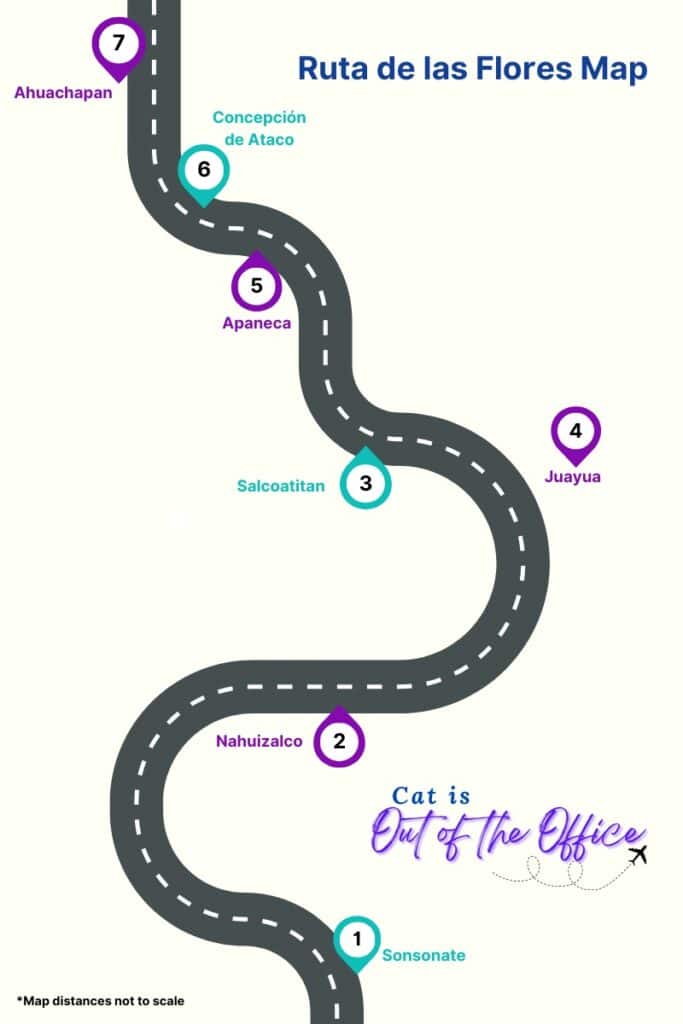
12. Explore Other Towns in Ruta de las Flores
Juayua’s location in the middle of Ruta de las Flores makes it an ideal base for exploring the surrounding towns.
Apaneca:
In Apaneca, I jumped at the chance to get lost in Central America’s largest plant maze. Sadly, the ziplines were closed due to the rainy weather, but they looked so fun!
Apaneca is also known for coffee tours, a deep dive into how El Salvador’s famous beans journey from soil to cup.
Concepción de Ataco:
Ataco brings the Ruta de las Flores to life with its vibrant murals and bustling weekend market.
The art here tells stories of local culture and history, making every walk an exploration. The night market is where you can taste local flavors and find unique crafts.
The Santa Teresa Hot Springs are a 20-minute drive from Ataco and are definitely worth a visit if you’re in need of some relaxation.
I wasn’t able to do the hike to Mirador de la Cruz due to a closed trail (another casualty of the rain).
Still, the delicious pupusas at Pupusa Primavera and Pupuseria Cielito Lindo made up for it. Cielito Lindo is most famous for selling Tenquiqe mushroom pupusas, a local delicacy known as the “Salvadorian truffle” that can only be found in El Salvador.
Salcoatitán:
Salcoatitán invites you to take it easy. Its colonial architecture and tranquil plazas set the stage for some of the best culinary experiences of my trip. =
This town is a haven for art lovers, with galleries and shops filled with handicrafts and striking mosaic murals.
Don’t miss the Printing Museum (Germinal Museo de la Imprenta) for a dive into the local history of print.
Weekends in Salcoatitán bring the central square to life, especially in front of the church, where a gastronomic festival showcases traditional yucca pupusas cooked over firewood.
Nahuizalco:
Nahuizalco is a town rich in history and culture, highlighted by the Pipil Náhuat Memorial Museum, which delves into the indigenous settlements, the 1932 massacre, and the area’s deep historical roots.
Last I checked, the museum was all in Spanish, so hire a local English-speaking guide if you need.
When visiting, don’t miss the chance to taste “canchules,” traditional tamales unique to the Day of the Dead festivities, along with other local specialties like yucca pupusas and sautéed yucca with pork rind.
The town is also known for its vibrant market of stores and workshops, where you can find and purchase distinctive handmade furniture and handicrafts that embody local craftsmanship.
Nahuizalco transforms at night with its candlelit market, creating a magical atmosphere for exploring local crafts.
The town’s indigenous heritage adds depth to the visit, offering insights into the traditions and history of the area.

Where to Eat in Juayua
Here are my top picks for the best places to eat in Juayua:
- Pupuseria Esmeralda: Hands down, the best pupusas I’ve tried in El Salvador. They’re fresh, and you can even request vegan options. It’s a must-visit for any foodie.
- Pupusería Y Taquería Doña Cony: A close second for amazing pupusas and local dishes. It’s where tradition meets taste in every bite.
- Restaurante San Jose: Perfect for breakfast and lunch, offering typical Salvadoran food that never disappoints. Their coffee and pastries are divine, and the fish and micheladas are standout choices.
- Restaurante R&R “Cocina Autor”: Known for its coffee flan and succulent steak, this place boasts a rooftop view that competes only with the quality of its food. Be prepared for a bit of a wait — everything’s made fresh. Though a tad pricier than other local spots, it’s well worth it for the local ingredients and stunning views.
- Delicias De Mexico: If you’re craving Mexican, this is the spot. The tortilla soup, burritos, and tacos are all excellent, and the prices are unbeatable.
- Pastelería y Cafeteria Festival: Despite the grumpy service, the local pastries, like guava-filled tarts and fresh bread, are irresistible.
- Bloom Cafe: A serene spot perfect for coffee lovers and readers. The baristas are coffee wizards eager to share their knowledge, making it a cozy place to unwind. The desserts can be a bit hit or miss, but when they hit, they’re spectacular.

How to Get to Juayua, El Salvador
Now that you’re clued into the best things to do in Juayua, the next step is figuring out how to get there.
I know firsthand that reaching Juayua can seem daunting, but I’ve broken it down to make your journey as smooth as possible.
Take a Tour:
Taking a day tour is hands-down the easiest way to discover the essence of Ruta de las Flores, especially if you’re pressed for time, prefer not to overnight, or the idea of navigating local transport or driving doesn’t appeal to you.
From San Salvador, Santa Ana, or La Libertad, reaching the heart of Ruta de las Flores can take anywhere from 1 to 2 hours by car, with local buses extending this journey further. A group tour simplifies this process, allowing you to soak in the beauty and culture of this region without the hassle of logistics.
⭐️⭐️⭐️⭐️⭐️
Thermal Tour – Bike Zipline + Hot Springs + Ataco
✅ Salto de Malacatiupan waterfalls
✅ Santa Teresa hot springs
✅ Bike zipline
Ruta de las Flores Group Tour – 4 Towns + Coffee Farm
✅ Visit 4 towns
✅ Coffee farm tour
✅ Max. 6 travelers
Ruta de las Flores Tour – Hotsprings + Coffee Tour + 2 Towns
✅ Santa Teresa hot springs
✅ Coffee farm tour
✅ Nahuizalco and Ataco towns
Go By Car:
Renting a car or hiring a driver provides flexibility and comfort, allowing you to explore at your own pace.
Driving in El Salvador is straightforward, but stick to daytime travel for the best experience.
Check DiscoverCars for the best deals on car rentals.
🚙 Thinking about renting a car in Central America? I rented a car in El Salvador and was able to see so much more than if I only traveled by bus. I recommend using Discover Cars to compare costs and get the best deal.

Take Local Transport:
For the adventurous soul, the chicken bus offers an authentic Salvadoran experience.
They’re lively, a bit unpredictable, but always memorable. Remember, patience and a flexible schedule are your best friends here.
- From San Salvador to Juayua: Start your journey by catching bus route 205 to Sonsonate or 249 to Ahuachapan. It’s a comfortable ride, costing around $0.75, and takes about 1.5 hours. Once in Sonsonate or Ahuachapan, hop on bus 249 (North from Sonsonate, South from Ahuachapan) directly to Juayua.
- From Santa Ana to Juayua: Grab bus number 238 directly to Juayua. It’s an affordable $0.80 ride and takes roughly 1.5 hours. Buses run frequently throughout the day, starting at 6:40 am, with the last bus at 6:30 pm.
Santa Ana to Juayua Bus Schedule:
- First Bus 6:40am (Gasolinera #1)
- 9:40am (Terminal)
- 11:45am (Terminal)
- 1:45pm (Terminal)
- 3:45pm (Terminal
- 5pm (Terminal)
- Last Bus 6:30pm (Terminal)
- From Coastal Areas (La Libertad, El Tunco, El Zonte) to Juayua: Take bus 287 to Sonsonate, a journey of about 2.5 hours costing $1.50. Buses leave La Libertad twice daily at 6am and 1:30pm (and stop in El Tunco and El Zonte shortly after). Once in Sonsonate or Ahuachapan, hop on bus 249 (North from Sonsonate, South from Ahuachapan) directly to Juayua.

Where to stay in Juayua
Juayúa is one of the most popular towns in Ruta de las Flores to spend the night.
Expect everything from quaint bed-and-breakfasts nestled amidst coffee plantations to luxe boutique hotels that promise comfort with a touch of opulence.
Note: “Hostal” in Spanish doesn’t translate to a “backpacker’s hostel” – the word typically means it’s an affordable hotel.
Hotel rooms in Juayua can be easily found for under $50 USD per night, and backpackers will be thrilled to find hostel dorms for under $15 per night.
- Hostal Doña Mercedes: One of the area’s only hostels with dorm rooms – perfect for backpackers. Features a dining area and a fully equipped shared kitchen for cooking. Enjoy a wonderful breakfast, free purified water, and an excellent location with common areas for socializing. Additional services include motorbike rental and laundry facilities. Check Reviews and Rates.
- Samay Hostel: A lively option for those seeking a social atmosphere, this hostel also offers dorm rooms catering to solo travelers and backpackers. There’s an abundance of bathrooms, a stunning rooftop area, and a well-equipped kitchen with everything you need to whip up a meal. The only minor drawback is the 10-minute uphill walk back from town – but think of it as your daily fitness routine! Check Reviews and Rates.
- Bourbon Hostal: Sitting near the Bus #249 stop, it’s an ideal base for your Ruta de las Flores explorations. Experience unrivaled hospitality with stunning city views, modern rooms, delicious breakfast at their stunning rooftop cafe, bilingual staff, and convenient airport shuttle service. Check Reviews and Rates.
- Hostal Deyluwin: Welcome to this tranquil guest house with inner courtyard views. Enjoy the comfort of air-conditioning and the convenience of an easy walk into the center of town. The shared kitchen with a full-size fridge lets you keep everything you need. While breakfast isn’t available, you can easily prepare your meals. And the beds are comfy, too! Check Reviews and Rates.
- Hotel Juayua: This small boutique hotel has a swimming pool and breathtaking volcano views. Enjoy the comfort of air-conditioning and the convenience of an on-site restaurant. While it may be pricier than other options, their outstanding staff will ensure an unforgettable stay. Check Reviews and Rates.

What to Do in Juayua El Salvador FAQs
What is Juayua known for?
Juayua, El Salvador, is renowned for its stunning waterfalls, the weekend gastronomic food festival, and its vibrant street art, making it a key destination along El Salvador’s Ruta de las Flores.
How do you pronounce Juayua?
Juayua is pronounced as “why-YOO-wuh,” emphasizing the second syllable.
How to get to Juayua from Santa Ana?
To get to Juayua from Santa Ana, take bus route 238 directly to Juayua. The journey is straightforward and offers scenic views along the way.
What is the history of Juayua?
The history of Juayua is deeply rooted in its pre-Columbian origins, with a rich cultural heritage that includes indigenous influences and Spanish colonial history, making it an important historical site in El Salvador.
What is there to do in Juayua?
In Juayua, visitors can trek the famous Seven Waterfalls, participate in the weekend food festival, enjoy the local street art, and engage in coffee plantation tours, among other outdoor activities.
Final Thoughts: Things to do in Juayua
Diving into Juayua and the Ruta de las Flores might seem like a bit of a trek, especially if you’re weighing the pros and cons of getting there.
Trust me, as someone who’s navigated the journey by both the lively local buses and by car, I can say it’s absolutely worth the effort. If you’re making your way to El Salvador, chances are you’re already an adventurer at heart, so you’ll navigate it just fine.
The thrill of the Seven Waterfalls Hike, the deliciousness of the weekend Food Festival, and the vibrant street art really make Juayua stand out. Juayua also makes the perfect base for exploring the other towns in the area, like Ataco and Apaneca.
If you’re tight on time or just not into planning every detail, a day tour is a fantastic way to see the highlights without the hassle.
And for those who can hang around a bit longer, diving into my detailed Ruta de las Flores Itinerary will ensure you don’t miss a thing.
So, whether you’re looking for a quick adventure or a deep dive into the area, Juayua has plenty to offer.
Read More About Ruta de las Flores:
- 15 Best Hotels in Ruta de las Flores (And Hostels!)
- Ruta de Las Flores: Ultimate Travel Guide + 17 Things to Do
- Ultimate Ruta de Las Flores Itinerary for 1-3 Days
- Best Ruta de las Flores Tours from San Salvador
- 12 Epic Things to Do in Juayua: El Salvador Hidden Gem
- Seven Waterfalls Hike El Salvador: Epic Juayua Adventure
- How to Get to Ruta de las Flores: 4 Options
- 10 Stunning Waterfalls in El Salvador that You Must See
- Best Time to Visit Ruta de las Flores: See Flowers in Bloom
- Juayua Food Festival Guide (by a Food-Obsessed Traveler)
📝 El Salvador Travel Planning Guide 🇸🇻🌟
Before you embark on your unforgettable journey to El Salvador, here are the essential tips every traveler should know:
🚑 Should I buy travel insurance for El Salvador?
✅ 100% YES! — My #1 Safety Tip for all travelers is to buy travel insurance for every trip in case anything happens on their visit. I recommend and use SafetyWing – it’s cheap and comprehensive.
🛟 Is El Salvador safe for tourists?
✅ YES, El Salvador is generally safe for tourists, but there are some areas to avoid. Ask your hotel for the most up-to-date information before heading out. When you’re out, stay alert, stick to busy streets, and avoid isolated areas. Read more about staying safe in El Salvador.
💧Can you drink the water in El Salvador?
🚱 No — It’s recommended to drink filtered or bottled water in El Salvador (but using tap water to brush your teeth is usually fine). I recommend this reusable water bottle! It works great, turning tap water into safe-to-drink water that tastes good.
🚙💨 Is it safe to rent a car in El Salvador?
Yes — Renting a car in El Salvador is one of the best ways to see the country! I recommend Discover Cars, which checks both international companies and local Salvadoran companies, so you get the best rates.
🏩 What’s the best way to book my El Salvador accommodations?
My go-to for El Salvador hotels is Booking.com. For hostels, I use HostelWorld. Or get free accommodations with Trusted Housesitters!
✈️ What’s the best site to book El Salvador flights?
For finding cheap El Salvador flights, I recommend CheapOAir.
🎫 Do I need a visa for El Salvador?
Likely Not — El Salvador allows visitors from close to one hundred jurisdictions to visit El Salvador without a visa and stay for up to 180 days. US passport holders don’t need an El Salvador visa for stays of up to 90 days, but you must purchase a tourist card for $12 USD upon arrival.
💰 𝗖𝘂𝗿𝗿𝗲𝗻𝗰𝘆: The currency here is the US Dollar, and there are plenty of ATMs if you need cash. I always withdraw from ATMs to get the best rates (select “no” when it asks you if you accept the conversion rate). Credit cards aren’t commonly accepted outside of major cities.
🪙 Tipping: Tipping 10% in restaurants is expected, but make sure it’s not already included in your bill as “servicio.”
🚕 𝗧𝗿𝗮𝗻𝘀𝗽𝗼𝗿𝘁𝗮𝘁𝗶𝗼𝗻: Getting around El Salvador is a breeze! Uber is safe and cheap in major cities like San Salvador and Santa Ana. Local buses are generally efficient and easy to use. Renting a car is also a good option.
🗣️ Language: Many locals don’t speak English, so brush up on your Spanish! It can also be helpful to download the Spanish language option on Google Translate if you’ll be offline.
📶 𝗖𝗼𝗻𝗻𝗲𝗰𝘁𝗶𝘃𝗶𝘁𝘆: El Salvador has inconsistent internet connectivity – it’s better in the main cities than in rural areas.

